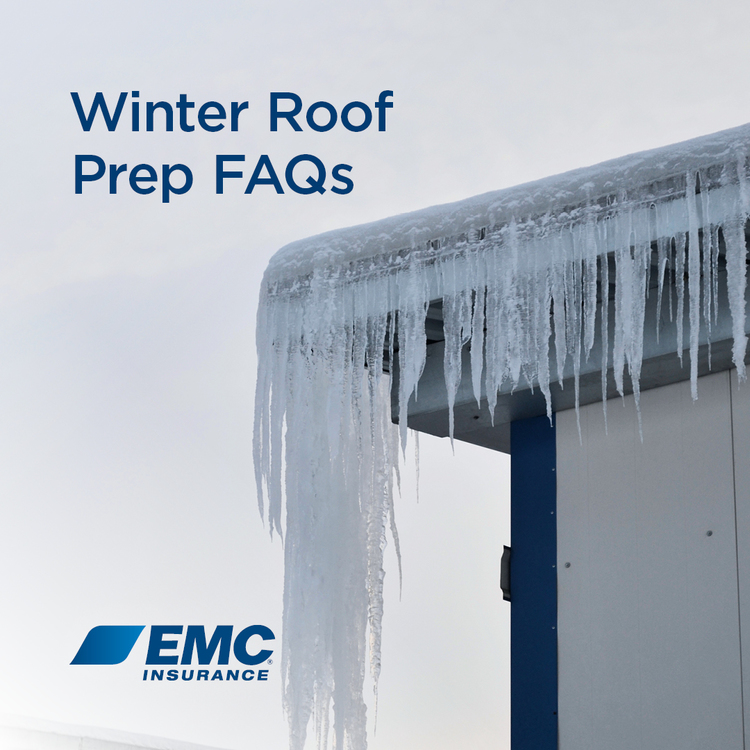Winter is rough on roofs. Make sure you’re ready with an inspection:

Winter is a rough time for the roofs of your municipal facilities. Harsh winds, the stress of freeze-thaw cycles and the weight of snow and ice can all contribute to a possible roof failure that could range from an inconvenient leak to a catastrophic collapse. Want to give your roofs a fighting chance at surviving the season in one piece? Add a fall roof inspection to your to-do list.
Why should I bother inspecting my roof?
Inspecting your roof really isn’t hard. Essentially, you’re just looking for minor issues that could turn into major issues if they aren’t repaired in a timely manner. Be getting ahead of possible roof problems, you help protect the financial investment the roof represents. In fact, regularly inspecting, maintaining and repairing your roofs can extend their useful life by five to ten years. Keeping the roof in good shape also helps protect the people, property and activities inside the building.
When should I conduct a roof inspection?
The National Roofing Contractors Association recommends inspecting your roof twice a year – once after the hottest part of the year subsides (fall) and again after the coldest part of the year has passed (spring). It’s also a good idea to check in on your roof after severe weather events or if you have new roof-mounted equipment installed.
Spotting problems before winter arrives is good. Damage that appears minor now can quickly become worse when exposed to winter temperatures and precipitation. Making needed repairs is also more challenging in the winter, when snow or ice might need to be removed before work can be completed or bad weather may delay safe access to the roof.
Can I do the inspection myself?
Depending on the technical expertise of you or your staff, you may be able to do the inspection yourself. Make sure you consider whether there is safe access to all areas of the roof and what kinds of fall protection might be needed. Remember, individuals performing repair and maintenance on rooftops must stay at least six feet away from the roof’s edge unless fall protection is in use. Examples of fall protection include guardrails, warning lines, fall restraints and fall-arrest systems. When considering how someone will get access to the roof, don’t forget to keep ladder safety in mind.
You may also choose to contract with a consultant. We recommend hiring a qualified roofing contractor who is well-established, licensed and bonded.
What am I looking for once I get up there?
Roof Edges – To keep water intrusion at bay, you want to make sure the roof edges are going to hold. Sheet metal and flashing should be uniform in appearance and securely attached. Look for gaps in the roof cover perimeter where water may seep in.
Roof Surfaces and Membrane – The surface of your roof is important because it keeps the insulation and interior of your building dry. For flat roofs, look for standing water (an indication of poor drainage), blisters, cracks and tears. If your roof system has rock ballast (rocks spread over the surface to hold the membrane down and protect it from hail), make sure it’s evenly distributed and that there are no bare spots.
On shingled roofs, look for worn, torn or missing shingles. One sign of deteriorating shingles to look for: shingle granules. These look like coarse sand, and finding them in your gutters means your shingles might be needing replacement soon.
Drainage – Check drains, scuppers and gutters to make sure they’re draining properly and remove leaves and debris that might block the flow of water. Standing water (known in the business as “ponding”) can lead to premature aging and deterioration of the roof cover, which will eventually cause leaks. In winter, you may get ice dams if water isn’t able to drain from the roof. You should also look at the downspouts to make sure the draining water has a place to go.
Areas Adjacent to the Roof – Examine walls and the areas around roof-mounted equipment, such as your HVAC system. Anything that’s cracked, torn or missing could be a concern. Look for deteriorating mortar on parapets and chimneys, and check the flashing around equipment and roof penetrations to make sure it’s strongly attached and well-sealed.
Building Interior – Your inspection should also include an interior hunt for signs of water damage, such as discoloration or bulging on the ceiling, bubbling drywall or expanded woodwork. If you notice any water intrusion, have it repaired ASAP.
How can I prepare for snow accumulation?
If you are located in an area where snow is common, it’s a good idea to create a roof snow removal plan. Identify areas that are prone to drifting snow, and pay special attention to those areas during the winter season. An architect or structural engineer can inspect your roof and determine the maximum depth of snow that your roof system can safely withstand. When snow accumulations reach half of that maximum, remove the snow from your roof to prevent overloading.
Check in on the roof periodically to make sure that any melting snow is draining properly and not ponding on the roof surface.
